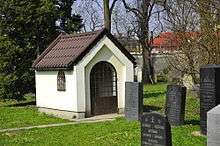Shimson Kleuger
Shimson Kleuger (also Szymon Klieger or Szymon Klüger) (January 19, 1925 to May 26, 2000) was the last Jew to live in the town of Oświęcim (German: Auschwitz) in Poland. He became known as "The Last Jew in Auschwitz".
Early life
Kleuger came from an Hasidic Jewish family who lived in Oświęcim. Not much is known about his life. The family had a small house was behind Oświęcim Synagogue. The house originally belonged to Szymon’s grandfather, Bernard Teichman and his daughter, Frymet. They bought it in 1928. Bernard Teichman was in the dry-goods trade in Oswiecim. He also owned a second hand goods shop in Bytom. Szymon’s father, Symcha, was a melamed, or religious teacher.[1]
During World War II, Shimson was interned in a concentration camp. Although it is not known where he was interned, the rabbi that prepared him for burial confirmed that he had a number used for identification of inmates in German concentration camps on his arm:
I can't say that means he was in Auschwitz, but he was in one of the camps, for sure.[2]
Of the nine Kleuger siblings, only three survived the Holocaust.[1] After his camp was liberated, Shimson Kleuger went to Sweden.
Later life in Oświęcim

Kleuger returned to Oświęcim in 1961, to find all the other Jews had left for America or Israel. Klueger took up residence in his family home and became a recluse, never venturing out. The townspeople left him food in a bowl outside the house.
... Shimshon Klueger had become a recluse, living in a hovel from which he never emerged, next to the abandoned synagogue.[2]
It seems that Kleuger was not quite a complete recluse. In his 1994 book, From Oswiecim to Auschwitz,[3] Moshe Weiss writes of a meeting with him:
Upon leaving the death camp at Auschwitz/Birkenau, I stopped in the town to visit Shimek Kluger, the last remaining Jew in Oświęcim. He offered me refreshments and an hour of gentle conversation, in which he reiterated his hope to leave Poland soon and join his brother and his family in Brooklyn, New York. Before departing, I presented him with a talit, a mezuzah, and two yarmulkes.
Death and burial

Klueger died in May 2000.[4][5] There were no Jews remaining in Oświęcim to prepare him for burial in the correct manner. Jewish law prescribes a ritual washing prior to burial. The closest rabbi, Rabbi Sacha Pecaric of Krakow, was summoned.[4] He went to the mortuary in Auschwitz to perform the taharah ceremony. A minyan, a quorum of 10 males over the age of 13, was also required. A busload of American Jewish students agreed to attend the funeral to make up this number.[4] Kleuger was the last person buried in the old Oświęcim Jewish cemetery which had been revived after the war.
Conversion of house to cafe
After Shimson Kleuger died his siblings, Moshe and Bronia, donated the house to the Auschwitz Jewish Center[6] which also runs the Oświęcim Synagogue and the adjacent Jewish museum.
The house was converted into a cafe called Cafe Bergson with the help of a Kickstarter campaign in 2014.[7] It is situated at Pl. Ks. J. Skarbka 5, 32-600 Oświęcim. The cafe also hosts cultural events. It is open daily 11 am – 7 pm
References
- "What is the AJC?". Wayback Machine. Archived from the original on 2010-03-25.
- Grossman, Ron. "The Last Goodbye in Auschwitz". Chicago Tribune.
- Moshe Weiss, From Oswiecim to Auschwitz
- "The last Jew living in the city of Auschwitz dies at 72". Jewish News of Northern California. 23 June 2000. Retrieved 18 February 2020.
- Singer, David; Grossman, Lawrence (2003). American Jewish Year Book 2002. VNR AG. p. 51. ISBN 978-0-87495-117-2.
- The Auschwitz Jewish Centre
- "Cafe Oshpitzin: Remember the Past, Feed the Future". Kickstarter.
External links
| Wikimedia Commons has media related to Szymon Kluger. |